Читать книгу Made in Italy: Food and Stories - Giorgio Locatelli - Страница 63
Bottarga
ОглавлениеThere are two kinds of bottarga, which is the salted, pressed and sun-dried roe of either grey mullet (muggine) or tuna (tonno). You should be able to find it in 50g or 100g blocks in good Italian delicatessens. Most of it comes from Sardegna and, since it is such a regional speciality, many Italians have never eaten it – my father never tasted it in his life, until I served it to him. Nowadays it has become something of a luxury, but I guess originally it was just another way for the fishermen to feed their families. They fished the grey mullet or tuna, cleaned them, took out the egg sac, sold the fish and then salted and dried the roe to eat at home.
If you visit the south of Sardegna they will tell you, categorically, that the amber-coloured grey mullet bottarga is best – partly because it is more rare, and because it takes two mullet to make one baffa (the commercial unit), whereas tuna are much bigger and the roe much more plentiful. Also, when the grey mullet roe is completely dry it becomes powdery, with a texture similar to Parmesan, and less powerful and salty-tasting. In other parts of the island and in Sicilia, though, they will insist that the tuna bottarga (which looks dark browny-grey and is slightly saltier and stronger and richer-tasting) is best.
Personally, I can’t say I like one better than the other; I love them both. For me, the best time to buy bottarga is in the spring; it is made all year round but early in the year the flavour is fantastic and the colour of the grey mullet roe is a brilliant yellow-orange. When the new batches of spring bottarga come into the kitchen, I have to stop myself just sitting there, slicing it and eating it then and there – it is beautiful on toasted bread, with some quite strong olive oil (as with Parmesan, never buy bottarga ready-grated, as all the flavour will be lost. Buy it in a piece and grate it yourself just before you need it). It is a curious flavour, a little like caviar, that opens up in your mouth and then you are hooked.
In Sardegna, grey mullet bottarga is usually served sliced, as part of the antipasti, with lots of olive oil and lemon juice. In Cagliari, in the south of the island, they serve it in a very purist way, just shaved, like a truffle, over pasta, with only a knob of butter and some pepper (no salt as the bottarga is salty enough). Butter seems to help the flavour of the bottarga, though it can also make it a little heavy, and because it has such a high fat content it needs plenty of seasoning with pepper or lemon juice – or something fresh like shavings of fennel – to cut through it.
Tuna bottarga is also produced in Sicilia, where you will sometimes find it served in a pasta sauce made with olive oil, chilli, garlic and parsley. Either way, it is an acquired taste, with such an intense flavour that when you serve it as a starter you set a very high note at the beginning of the meal, which you have to follow with powerful flavours.
